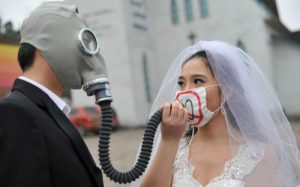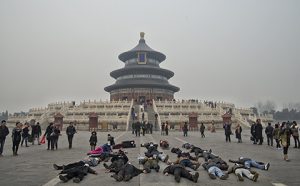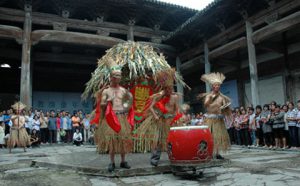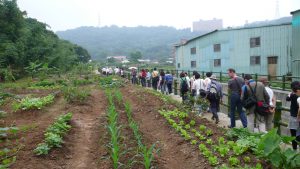Xiangzi and Wang Tianmo sit in the middle of a pile of old clothes, happily trying on woollen jumpers and old coats.
This is Pi village, between Beijing’s east fifth and sixth ring roads, mostly home to families of migrant workers.
Xiangzi is a north-easterner with Canadian citizenship. Wang Tianmo is a young designer more likely to be found in her London studio.
But since 2011 Xiangzi and his friends have made an annual trip here to Pi, to go “treasure-hunting” in the old clothes.
Wang makes new clothes from old – something you might expect a frugal grandmother to be doing. Xiangzi gathers together designers like Wang and supplies them with patchwork cloth made from the old clothes. The designers create new clothes and Xiangzi sells them on at a hefty mark-up. The bulk of the income, once the designers’ fees are covered, is given to the local women who stitch together the patchwork cloth.
Since 2006, the social enterprise Beijing Migrant Workers’ Home has opened twelve shops selling second-hand clothes at prices migrant workers can afford. These shops have brought overseas designers and female workers together.
These are designers unwilling to submit to commercialism. Xiangzi runs a shop on the trendy Wudaoying Hutong, and though he loves the second-hand clothes, business is not good. But the designers who work with him all have their own brands and a love of second-hand clothes.
Zhang Na has been working with Xiangzi the longest, and has her own independent label. Reusing old cloth has taught her to value the material, and the income helps vulnerable groups.
Patching kindness together
Xiangzi started selling second-hand clothes in 2009 to support rural women. But after two years he’d only sold a few items.
He realised Chinese people weren’t keen on the idea of second-hand clothes. Apart from worries about hygiene, they felt it was “inauspicious” to wear old clothes or even a symbol of failure. But in the US, Europe and Japan, organisations such as Goodwill and the Salvation Army operate large numbers of charity shops and even high-earners will shop there.
So if second-hand clothes weren’t selling, Xiangxi decided he could remake them into new clothes.
He started looking for material in Pi village in 2011. A friend from England pointed out that as well as usual methods of turning jeans into satchels, suits into waistcoats or vests into rags, old garments could be made into patchwork cloth. This discovery reinvigorated Xiangzi’s struggling business.
Xiangzi took the first piece of cloth to Zhang Na in Shanghai, the first of what would become a steady flow of material. Zhang Na made twelve jackets as an experiment, and she sold all of them except the one she kept for herself.
The patchwork cloth gives the clothes a strong sense of style which challenges mainstream fashion: the original form of the cloth has been broken down and remade for charitable purposes. With few charity shops in China, these remade clothes offer an unusual and alternative option.
Xiangzi realised the limitations of what he was trying to do from the start. “The idea of remaking clothes is environmentally friendly, but it might not be once you’ve taken them apart and washed and restitched them. Protecting the environment should be a deeply-ingrained habit.” Zhang Na doesn’t like to label the clothes as environmentally friendly to boost sales. “I want them to like my designs first. Alignment with the values should come later.”
A three-phrase slogan was invented to sum up the brand’s aim: do good, look good, feel good.
Old clothes for the red carpet
In April 2013 a young Beijinger bought a “sock bag”, an Austrian-designed bag made up from dozens of old socks, from Xiangzi’s shop. Those bags sold better than anybody expected. In little more than a month five out of six were sold.
Linda Chang, wife of the first Canadian ambassador to Myanmar, is also a fan. In April 2013 she wore a blue-grey blouse made by Zhang Na to the closing ceremony of the Beijing International Film Festival.
Linda takes part in a several charitable activities, and often buys clothes and bags from Xiangzi and makes a point of wearing them where they will be seen. And she chose Zhang Na’s blouse because “it’s pretty, well-designed, carefully made and wasn’t inferior to any of the other designer clothes that night.”
The remade clothes aren’t much harder to make than normal clothes. But the people involved – the designers, shoppers and volunteers – are different.
The project now has its own dedicated cloth designer – something that doesn’t happen in traditional clothes-making.
Zhang Na has also created a reclothing bank, taking in any unwanted clothes, whether the last season’s designer items or friends’ old clothes, and unwanted material.
Reclothing has become big hit among celebrities. Musician Zhu Zheqin owns a patchwork cape. Television host Hung Huang has donated clothes to Zhang Na. Up and coming movie star Ni Ni wore these clothes for a cover shoot, and TV presenter Xie Na recently used cloth from Xiangzi’s shop as a backdrop for the launch of her own clothing line.
At the beginning Xiangzi and Zhang Na never thought ordinary people would take to their clothes. But one day in April or May of 2012 Zhang Na was stopped in the street by an old lady who asked where her clothes came from. And when she heard how they were made, she instead on getting involved.
More praise than sales
The new style is attracting more and more people, with clothing designers joining in, and one company donating a batch of unwanted material. An American department store also donated several modern sewing machines to the women making the cloth.
But despite all the praise, sales are low. The biggest problem is output – they’re not working on a large scale, and the cost of using the recycled cloth is actually higher than using new material.
Xiangzi’s shop is a mere five square metres in size, and the cooperative only has six women working for it, meaning there is a shortage of cloth. And the designers can only work on the clothes when they’ve finished their own projects.
Hoping to solve these problems, Xiangzi raised some funds and found a small clothing company on the south side of Beijing to work with. That workshop, with twenty or thirty employees, will be the first company to produce recycled clothes. Zhang Na has also just rented a new and much bigger workspace and hopes to increase the number of products produced.
But the woman’s cooperative is still in charge of producing the cloth. This is the charitable part of the enterprise, designed to help out female migrant workers. The name of Xiangzi’s shop even translates as “Brand Woman”. Nobody involved wants to forget why they’re doing this.
This article was originally published in Southern Weekend.





